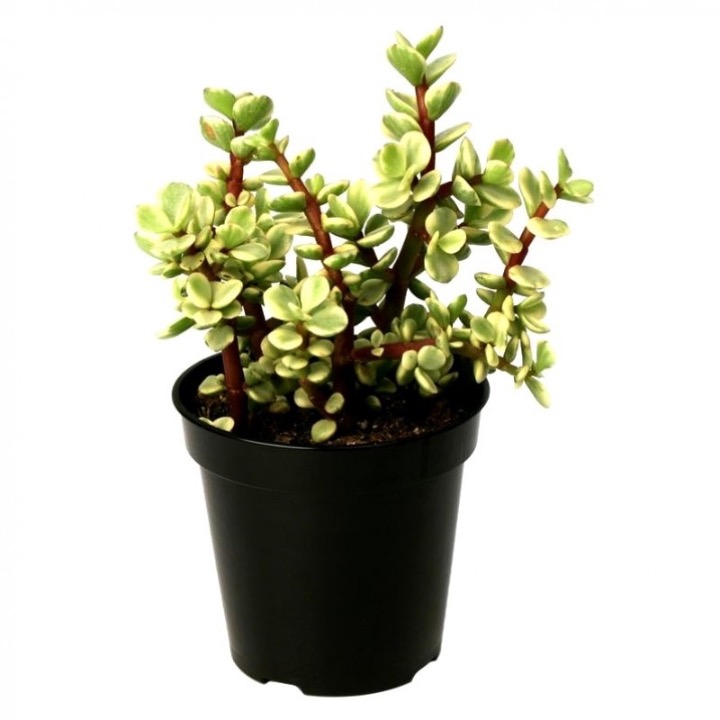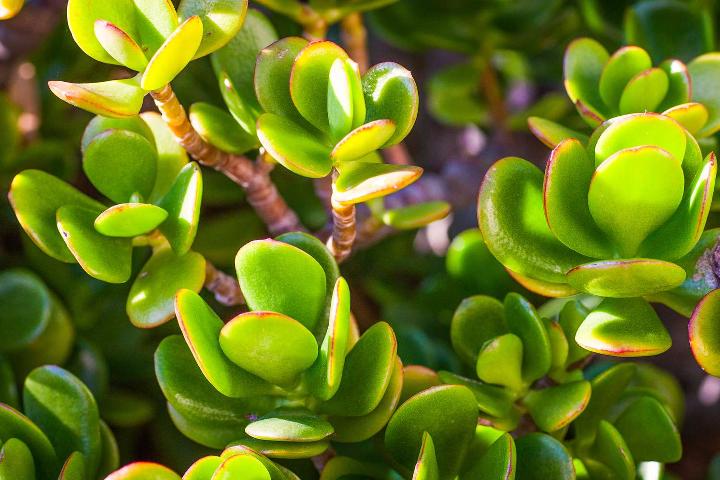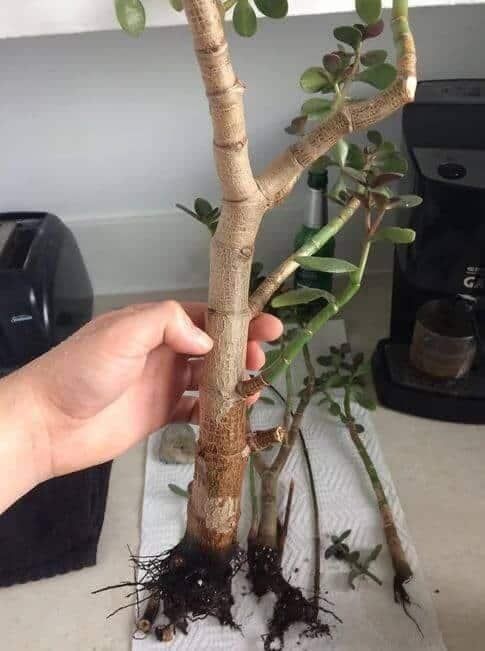Variegated Jade Plant
Variegated Jade (Crassula ovata), also known as Money Plant or Jade Plant, is a succulent often grown in hanging baskets. Plant in well-draining soil and provide bright, indirect light. Allow the soil to dry between waterings. Pruning can be done to control the size and shape of the plant.
Habit
Perennial
Height
0.3 to 1.0 m
Growth
Moderate
Soil
Well-drained, Sandy Loam
Shade
Full Sun to partial shade
Moisture
Wet to moist
Edible
Yes
Medicinal
Yes
Origin
South Africa
Climatic Condition
Tropical, Subtropical
Temperature (°)
20°C to 30°C
Humidity (%)
50% to 60%
Potting media
50% Loam, 40% Sand, 10% Organic Matter
Fertilizers
Organic Fertilizer
Watering
Regular watering
Plant Weight
0.5 to 1.0 kg
Flowering Time
Spring to Fall
Soil Ph level
6.0 to 7.5
Water Ph level
6.0 to 7.0
Soil EC
0.4 to 0.6 mS/cm
Yield Per Plant
2 to 3 kg per plant
NPK ratio
10:10:10
life Span
5 to 7 years
Health Benefits
Ornamental, Air-purifying
Suggested Grow Media or Potting Mix ?
50% perlite, 30% potting soil, 20% coarse sand
Suggested Fertigation/Fertilizers
Fertilize every 4-6 weeks with a balanced, water-soluble fertilizer.
Common Diseases and Remedies
Bacterial soft rot and Powdery mildew.
Bacteria effects the plant parts & plant parts get mushy and smelly.
Remove the infected part , avoid over watering
HEALTH BENEFITS
1. Air-purifying properties: Variegated jade hanging can help purify the air by removing toxins and pollutants.
2. May help reduce stress: Variegated jade hanging's calming appearance may help reduce stress and promote relaxation.
3. May have antimicrobial properties: Variegated jade hanging may have antimicrobial properties that can help prevent infections.
What Is An Jade Tree?
A variegated jade plant, experimentally known as Crassula ovata 'Variegata,' is a striking cultivar of the famous jade plant. This assortment is valued for its staggering appearance, highlighting leaves that show a special mix of green, white, cream, or yellow tones. The variegation can take different structures, including stripes, spots, or marbling, making a delightful difference against the run of the mill dim green tint of the customary jade plant.

What Are The Different Types Of Jade Plants?
1. Crassula ovata 'Variegata'
This is the exemplary variegated jade plant, highlighting leaves with a blend of green and white or cream tones. The variegation can be as stripes, spots, or fixes.
2. Crassula ovata 'Tricolor
Otherwise called the rainbow jade plant, this assortment highlights leaves with three tones — green, cream, and pink. The pink shading is most unmistakable along the edges of the leaves, making a wonderful difference.
3. Crassula ovata 'Lemon and Lime'
This assortment has leaves that are prevalently green however with striking yellow or lime green variegation, giving it a splendid and lively appearance.
4. Crassula ovata 'Gollum Variegata'
A remarkable cultivar with rounded leaves that have variegation along the edges. The variegation can go from white to yellow, making a particular look.
5. Crassula ovata 'Sunset
This assortment highlights leaves that are a blend of green, yellow, and pink, making a nightfall like impact. The tones are most energetic when the plant is filled in splendid light.

How to Care Jade Plant ?
1. location
Variegated jade plants, similar to their non-variegated partners, favor an area with splendid, roundabout daylight. They can endure some immediate daylight, particularly toward the beginning of the day or late evening, however an excess of direct daylight can burn their leaves.
2. sunshine
Inside, place your variegated jade plant close to a south-bound window where it can get a lot of brilliant, backhanded daylight. On the off chance that you don't have a south-bound window, an east or west-bound window can likewise work, yet you might have to turn the plant every so often to guarantee even development.
3. Soil
Variegated jade plants, as different succulents, require well-depleting soil to flourish. A decent soil blend for variegated jade plants ought to be coarse and permeable to keep water from pooling around the roots, which can prompt root decay.
4. hydration
Water your variegated jade plant when the top inch or two of the dirt feels dry to the touch. Contingent upon the environment and indoor circumstances, this could go from once every 1 fourteen days in hotter months to once every 3 a month in cooler months.
5. Nourishment
1. *Fertilizer type*: Utilize a decent, water-dissolvable compost planned for succulents or desert plants. Search for a compost with a NPK proportion of around 2:1:2 or 3:1:2. This reasonable proportion guarantees that the plant gets sufficient measures of nitrogen (N), phosphorus (P), and potassium (K), as well as micronutrients.
2. *Frequency*: Treat your variegated jade plant sparingly, regularly once every 2 a month during the developing season (spring and summer). Decrease or quit treating during the plant's torpid period (fall and winter).
3. *Dilution*: Consistently weaken the manure to half or a fourth of the prescribed solidarity to abstain from over-treating, which can harm the plant's underlying

6.Issues
1. *Overwatering*: One of the most well-known issues with variegated jade plants is overwatering, which can prompt root decay. Permit the dirt to dry out between waterings to forestall this issue.
2. *Sunburn*: While variegated jade plants need a lot of daylight, an excess of direct daylight can cause sun related burn, particularly on the variegated pieces of the leaves. Safeguard your plant from extraordinary, direct daylight, particularly during the most sizzling piece of the day.
What are the Benefits of Variegated Plant ?
1. *Aesthetic appeal*: The variegated leaves of jade plants add a beautiful and unique touch to any space. Their striking colors and patterns can brighten up a room or garden and create a visually appealing focal point.
2. *Low maintenance*: Like other succulents, variegated jade plants are relatively easy to care for and require minimal attention. They are drought-tolerant and can survive in various conditions, making them ideal for busy or novice gardeners.
3. *Air purification*: Variegated jade plants, like other houseplants, can help improve indoor air quality by absorbing carbon dioxide and releasing oxygen. They can also remove toxins such as formaldehyde and benzene from the air, creating a healthier indoor environment.

FAQs About Growing Jade
1. How to maintain variegated jade plant ?
Place your variegated jade plant in a location where it receives bright, indirect sunlight. Avoid placing it in direct sunlight for extended periods, as this can cause sunburn.
2. what are the uses of variegated jade plant?
Variegated jade plants are popular houseplants and are often used to add a touch of greenery and color to indoor spaces. Their unique variegated leaves make them a striking addition to any room.
3. can I grow variegated jade plant indoor?
Place your variegated jade plant in a location where it receives bright, indirect sunlight. A south-facing window is ideal. Rotate the plant occasionally to ensure even growth.
4. which pot is best for growing variegated jade plant?
Choose a pot with drainage holes at the bottom to allow excess water to escape. This helps prevent overwatering and root rot, which can be detrimental to your plant.
5.From where can I shop variegated jade Plant?
Visit local nurseries or garden centers in your area to see if they carry variegated jade plants. They may have a selection of sizes and varieties to choose from.

